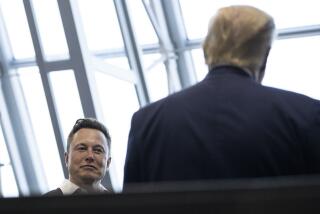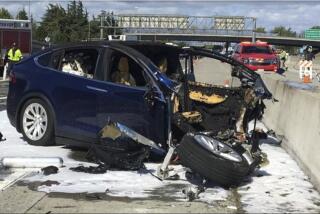High-Tech Product Development Is Demystified in Guru’s New Book
- Share via
Here’s the burning question that tortures a multitude of geeks and marketers in Silicon Valley: “With so many instant millionaires around here, why ain’t I one of ‘em?”
Guy Kawasaki, the original Macintosh evangelist and now chief executive of Palo Alto-based Garage.com--an outfit that provides seed capital to high-tech start-ups and helps them connect to the real moneybags (sort of a baby venture-capital firm)--takes a stab at the answer in his latest book: “Rules for Revolutionaries: The Capitalist Manifesto for Creating and Marketing New Products and Services” (HarperBusiness, $25).
If you worked all weekend to meet a big product deadline, or if you’re desperate for that big break before you reach 30 (or, heaven forbid, 50), read on. This book may provide a painless way to avoid Dilbert-esque miscues that have humbled many of Silicon Valley’s high and mighty.
Kawasaki, a famous raconteur, offers a list of wise-guy witticisms and anecdotes that avoids the pretense, dross and revisionism of most advisory tomes written by executives.
Even if you merely use technology, this book may be worth a peek, because it brings high-tech product development down to the level consumers can understand. A few examples:
On complexity:
“Send one of your products to your parents or your in-laws. See if they can set it up. If not, see if you can explain how to set it up on the telephone.”
On understanding the customer’s experience:
“Imagine if these practices were put into place:
“A. Members of Congress were required to fill out their own tax returns.
“B. Airline company executives ate the same food that passengers ate in planes.
“C. State governors had to register their own cars at the department of motor vehicles.
“D. Computer executives updated their own software.”
On overwork:
“Mandate that your building will be open for set hours such as 8 a.m. to 6 p.m. Let no one work in the building before or after these hours. When the supply of office time is finite (that is, 10 hours), you are likely to find that people focus on their work, meetings are shorter, and everyone is healthier.”
Where did Kawasaki get his material? Mostly from his work for Apple, poster child for the brilliance and foolishness that epitomizes Silicon Valley.
Garage.com helps companies that start small but have big ideas, like the legendary examples of Apple and Hewlett-Packard, which literally began in garages.
Such stories tend to track the dawn of a major technology, such as the microprocessor, PC or World Wide Web. Upheaval opens unseen opportunities that nimble newcomers exploit while the big boys remain mired in fading models.
*
But once the big companies start buying up the innovators, doesn’t that squeeze out the prospects for a garage scenario?
Kawasaki’s heavy sigh in response to that question made me realize why he’s not selling any more. He seemed fatigued that people don’t get it yet.
“But compared to justifying why Apple won’t die, [answering is] a blast,” he quipped. (His answer to that, by the way: “My explanation for the continued survival of Apple is the existence of God.”)
Garage start-ups will continue for one simple reason: churn. “WordStar and Lotus and Ashton-Tate were going to dominate the world,” Kawasaki said of the onetime software steamrollers. “It’s always going to be true that two guys in a garage can start a company.”
Start, yes, but can you become rich? Possibly. But you might consider Las Vegas as an alternative.
Consider that for every Jerry Yang--one of Yahoo’s twentysomething billionaire founders--there are thousands of wannabes.
Since its founding last year, Garage.com has funded seven projects from some 3,000 proposals. A top tier venture-capital firm funds one in 1,000.
Consider also Kawasaki’s biggest surprise since working at Garage.com: “Ideas travel in packs. In the space of two weeks, we’ll get four plans on the same kind of idea.”
So what does it take to break out of the pack?
A sense of the big picture. Kawasaki suggests the model of Thomas Edison, both an inventor and a businessman who foresaw the entire electrical-lighting infrastructure, then staked out patents and business plans to create it while his competitors fiddled with perfecting bulb filaments.
Who sees the big picture in today’s Internet economy, according to Kawasaki?
Bill Gates, Steve Case, Christos Cotsakos and Bob Lessin, chief executives, respectively, of Microsoft, America Online, E-Trade and Wit Capital (a firm dedicated to helping individual investors cash in on high-tech public offerings--the ground floor of vast wealth).
I do have one problem with this book: Its cliched cheapening of the word “revolutionary.” Boston, 1773, St. Petersburg, 1917--those were revolutionary moments.
The automobile changed the world as we know it; the automatic transmission did not. The telephone, television, computer and Web all changed society profoundly. Quicken, the Palm Pilot, Netscape Navigator and yes, even the Macintosh have been phenomenally successful and important, but hardly revolutionary.
(I’ll grant that locking the doors of a business at 6 p.m. might count as revolutionary because, if widely implemented, it would help millions of entrepreneurs and their employees get a life.)
The central lesson in this book is more prosaic: how to be more sensible and effective about making money. That’s plenty for 200 pages.
*
Times staff writer Charles Piller can be reached via e-mail at charles.piller@latimes.com.
More to Read
Sign up for our Book Club newsletter
Get the latest news, events and more from the Los Angeles Times Book Club, and help us get L.A. reading and talking.
You may occasionally receive promotional content from the Los Angeles Times.










